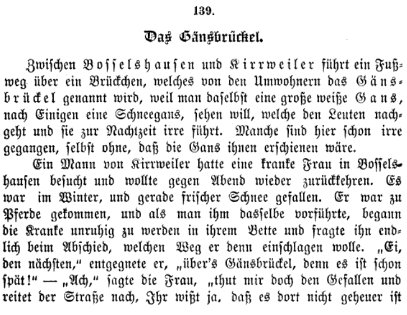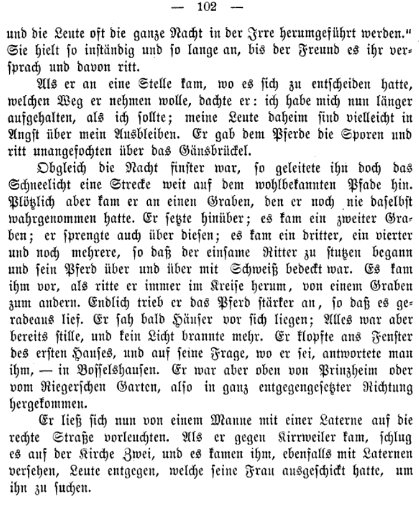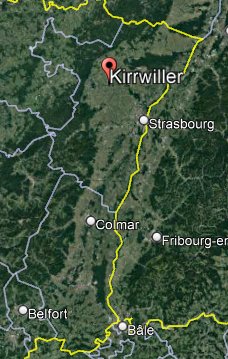ALSACAT-1800-00-00-KIRRWILLER-1
Following the example of Frédéric Dumerchat, Bertrand Méheust, or Jacques Vallée, in his chapter devoted to celestial legends and wonders before the era of flying saucers in Alsace, Christian Valentin pointed out that there are stories in the Alsatian folklore from the middle of the 19th century collected and published by the folklorist Auguste Stoeber, concerning "ghost stagecoaches" and "flying coaches", with or without coachman, with a few variations, including one in Kirrwiller.
| Date: | in the 1800's |
|---|---|
| Time: | Evening or night. |
| Duration: | ? |
| First known report date: | 1896 |
| Reporting delay: | Years, decades. |
| Department: | Bas-Rhin |
|---|---|
| City: | Kirrwiller |
| Place: | The Small Bridge of the Goose. |
| Latitude: | 48.808 |
| Longitude: | 7.522 |
| Uncertainty radius: | 1 km. |
| Number of alleged witnesses: | 1 |
|---|---|
| Number of known witnesses: | 0 |
| Number of named witnesses: | 0 |
| Witness(es) ages: | Adult. |
| Witness(es) types: | Local man. |
| Reporting channel: | Legend recorded by Auguste Stoeber. |
|---|---|
| Type of location: | Country. |
| Visibility conditions: | Night. |
| UFO observed: | No. |
| UFO arrival observed: | N/A |
| UFO departure observed: | N/A |
| Entities: | No. |
| Photographs: | No. |
| Sketch(s) by witness(es): | No. |
| Sketch(es) approved by witness(es): | No. |
| Witness(es) feelings: | ? |
| Witnesses interpretation: | ? |
| Hynek: | N/A |
|---|---|
| ALSACAT: | Not UFO-related. |
[Ref. asr1:] AUGUSTE STOEBER:

|

|
Zwischen Bosselshausen und Kirrweiler führt ein Fußweg über ein Brückchen, welches von den Umwohnern das Gänsbrückel genannt wird, weil man daselbst eine große weiße Gans, nach Einigen eine Schneegans, sehen will, welche den Leute nachgeht und die zur Nachtzeit irre führt. Manche sind hier schon irre gegangen, selbst ohne, das die Gans ihnen erschienen wäre.
Ein Mann von Kirrweiler hatte eine kranke Frau in Bosselshausen besucht und wollte gegen Abend wieder zurückkehren. Es war im Winter, und gerade frischer Schnee gefallen. Er war zu Pferde gekommen, und als man ihm dasselbe vorführte, begann die Kranke unruhig zu werden in ihrem Bette und fragte ihn endlich beim Abschied, welchen Weg er denn einschlagen wolle. "Ei, den nächsten," entgegnete er, "über's Gänzbruckel, den es ist schon spät!" - "Ach, sagte du Frau, "thut mit doch den Gefallen und reitet der Straße nach, Ihr wißt ja, das es dort nicht geheur ist und die Leute oft die ganze Nacht in der Irre herumgeführt werden." Sie hielt so inständig und so lange an, bis der Freund es ihr versprach und davon ritt. Als er an eine Stelle kam, wo es sich zu entscheiden hatte, welchen Weg er nehmen wolle, dachte er: ich habe mich nun länger aufgehalten als ich sollte; meine Leute daheim sind vielleicht in Angst über mein Ausbleiben.
Er gab dem Pferde die Sporen und ritt unangefochten über das Gänsbrückel. Obgleich die Nacht finster war, so geleitete ihn doch das Schneelicht eine Strecke weit auf dem wohlbekannten Pfade hin. Plöglich aber kam er an einen Graben, den er noch nie daselbst wahrgenommen hatte. Er seßte hinüber; es kam ein zweiter Graben; er sprengte auch über diesen; es kam ein dritter, ein vierter und noch mehrere, so daß der einsame Ritter zu stugen begann und sein Pferd über une über mit Schweiss bedeckt war.
Es kam ihm vor, als ritte er immer im Kreise herum, von einem Graben zum andern. Endlich trieb er das Pferd stärker an, so daß es geradeaus lief. Er sah bald Häuser vor sich liegen; Alles war aber bereits stille, und kein Licht brannte mehr. Er klopfte ans Fenster des ersten Hauses, und auf seine Frage, wo er sei, antwortete man ihm, in Bosselshausen. Er war aber oben von Prinzheirn oder vorn Riegerschen Garten, also in ganz entgegengeseßter Richtung hergekommen.
Er ließ sich nun von einem Manne mit einer Laterne auf die rechte Straße vorleuchten. Als er gegen Kirrweiler kam, schlug es auf der Kirche Zwei, und es kamen ihm, ebenfalls mit Laternen versehen, Leute entgegen, welche seine Frau ausgeschickt hatte, um ihn zu suchen.
In English:
Between Bosselshausen and Kirrweiler, a path leads over a small bridge, which the locals call the Gänsbrückel [the bridge of the geese], because there you get to see a big white goose, according to some a snow goose, which follows people and which leads them astray in the night. Some have wandered off here without even seeing the goose.
A man from Kirrweiler had visited a sick woman in Bosselshausen and wanted to come back in the evening. It was winter and fresh snow had just fallen. He had come on horseback, and when the same thing was shown to him, the patient began to fidget in her bed, and finally, on parting, asked him which direction he wanted to take. "Oh, the shortest," he replied, "over the Gänzbruckel, it's already late!" "Oh," said the woman, "do me a favor and walk down the street, you know it's not safe there and people are often misled all night." She was so serious and insistent, until her friend promised her and rode. Coming to a point where he had to decide which direction to take, he thought: I stayed longer than I should have, my people are at home maybe worried about my absence.
He spurred the horse and rode without hesitation on the Gänsbrückel. Although the night was dark, the light of the snow led him a distance along the well-known path. However, suddenly he came to a ditch he had never seen there. He sat down; there was a second ditch; he jumped on this one too; a third came, a fourth and more, so that the lone rider began to mount and his horse was all covered with sweat.
It seemed to him that he was always going around in circles, from one ditch to another. Finally he pushed the horse harder so that it ran straight ahead. He soon saw houses in front of him; but everything was already quiet and no lights were on. He knocked on the window of the first house, and when he asked where he was, he was told that it was in Bosselshausen. But he had come from up there, from the Prinzheirn or the Riegerschen Garten, that is to say in the opposite direction.
He now let a man with a lantern light him down the street to the right. When he arrived at Kirrweiler, two chimes rang in the church, and people, also carrying lanterns, came towards him, his wife having sent them to look for him.
[Ref. grh1:] GEORGES RUCH:
Eine ähnliche Geschichte erzählt Stöber auch von einem Mann aus Kirweiler, der nach einem Besuch in Bosselshausen, zu Pferd, am "Gänsbrückel" den Weg verlor und stundenlang umherirrte. Lange nach Mitternacht kam er an ein Dorf und erfuhr, dass er wieder nach Bosselshausen gekommen war, von der entgegengesetzten Seite!
I.e.:
Stöber tells a similar story about a man from Kirweiler who, after a visit to Bosselshausen, on horseback, lost his way at the "Gänsbrückel" ["Goose bridge"] and wandered around for hours. Long after midnight he came to a village and learned that he had come back to Bosselshausen, from the opposite side!
[Ref. cvn1:] CHRISTIAN VALENTIN:
In his first chapter devoted to legends and celestial wonders before the era of flying saucers in Alsace, Christian Valentin points out that there are stories of the Alsatian folklore from the middle of the 19th century collected and published by the folklorist Auguste Stoeber, about "phantom stagecoaches" and "flying coaches", with or without coachman, with some variations, at Kirrwiller, Bouxwiller, Ribeauville, Grussenheim and Biesheim.
These coaches rise in the air and cause great fright to the passengers, and when they fail to jump before the coach gets too high, they find themselves, either in no time at their destination, or waking up hours later in an unknown and distant place.
He notices that these stories on the border between the world of the living and the imagination are often tinged with phantasmagoria and strange visions, that they are repeated from generation to generation. He remarks that it is tempting to draw a parallel between these accounts and the accounts of alien abductions, and "missing time", of modern times.
He wonders whether the "flying saucers" to come would not be a modern adaptation of a broader and more complex phenomenon, present in all eras, an opinion which will be developed at the end of the 1960s by Jacques Vallée in his book "Chronique des apparitions extraterrestres" ["Passport to Magonia"], Denoël 1972, which brought together popular beliefs from oral tradition and the phenomenon of flying saucers.
Kirrwiller is the Alsatian and French name of the village. During the German periods of Alsace, the village was named "Kirrweiler".

|
Some ufologists or Fortean researchers focus, for various reasons, to looking in old texts, dated before the "flying saucers era", for stories that would relate to this topic.
Among their reasons, some are contradictory. Some seek to demonstrate that "flying saucers" cannot be a "modern hype" since ancient stories from before this supposed hype were already reporting UFOs. Others want to show that "flying saucers" are indeed the modern version of old nonsense such as religious appearances or stories of "flying coaches" whose only connection with the UFO question is that nonsense always existed.
Some of these researchers have become specialists in such ancient stories, foaming libraries to find in old newspapers or books of legends texts recounting alleged facts more or less obviously suggestive of "flying saucers". We can think of Jacques Vallée, Jean Sider, Chris Aubeck and many others, including the Alsatian Christian Valentin who listed some stories of this kind in my area - with caution, as I do.
To be clear, I do not think any argument can be seriously held from such documents. These are not established "facts", there is almost never any contemporary investigation or verification, it is usually too late to try to establish any "truth" in it. Sometimes, however, we can show that the "case" was only a misinterpretation, sometimes a hoax, usually we can only pronounce that the story cannot be taken at face value, that nothing can demonstrate that it is a factual narrative.
So then I would not have to mention cases like the one I'm filing here.
But that would expose me to a critique regularly made by some ufologists who think that a priori rejection of such material is to be "blind" or close minded or in denial of this or that thesis.
So as I don't want to be subjected to this sort of criticism, I document this case. Even though there is no mention of the story in the UFO literature, apparently nobody found out about this story yet, I give the report, documented and referenced, and my comment.
In the present case, the primary source, which is Auguste Stoeber's text, actually does not mention any flying coach, there is no abduction, no strange being - even the white goose has nothing strange, no missing time.
The story is just that of a man who gets lost in a place where local legends say people often get lost.
Now, it should be noted that there have been several legends that could be located in Kirrwiller, and it is not clear which one was in question here; I also document the other "Kirrwiller" legends, some actually having more weirdness than this one.
Not UFO-related.
* = Source is available to me.
? = Source I am told about but could not get so far. Help needed.
| Main author: | Patrick Gross |
|---|---|
| Contributors: | None |
| Reviewers: | None |
| Editor: | Patrick Gross |
| Version: | Create/changed by: | Date: | Description: |
|---|---|---|---|
| 0.1 | Patrick Gross | February 23, 2023 | Creation, [cvn1]. |
| 1.0 | Patrick Gross | February 23, 2023 | First published. |